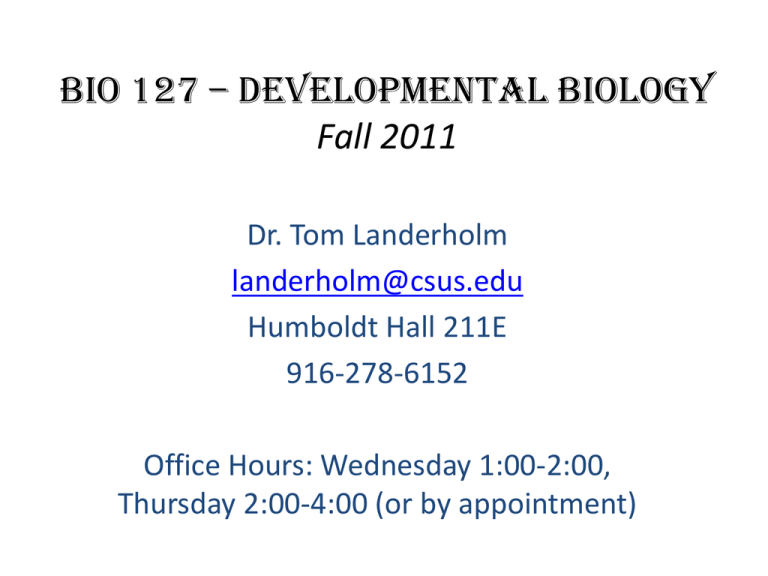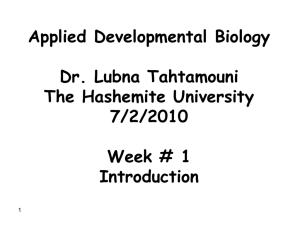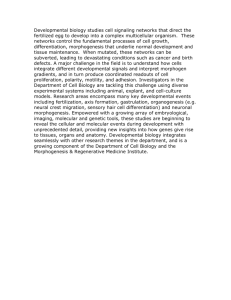BIO 127 * Developmental Biology Fall 2010
advertisement

BIO 127 – Developmental Biology Fall 2011 Dr. Tom Landerholm landerholm@csus.edu Humboldt Hall 211E 916-278-6152 Office Hours: Wednesday 1:00-2:00, Thursday 2:00-4:00 (or by appointment) Course Organization • • • • • Section I: Developmental Terms and Processes Section II: Early Development Section III: Development of Organ Systems I Section IV: Development of Organ Systems II Section V: Late Development and Other Topics • Labs are designed as extensions of the lectures – Exams will cover both together as a unit Grades will be based on the result of four exams, 8 laboratory write-ups, the presentation of your poster and participation in the lab as follows: A(-) > 90%, B(+) > 80%, C(+) > 70%, D(+) > 60%, and F < 60% Exam 1 Friday 09/16 100 points Exam 2 Friday 10/07 100 points Exam 3 Friday 10/28 100 points Exam 4 Friday 11/18 100 points Exam 5 Wed. 12/14 100 points Lab Write-ups 8 total Project presentation 12/09 200 points 50 points Total Points 750 Bio 127 - Section I Developmental Terms and Processes The Big Picture Developmental Anatomy Gilbert 9e – Chapter 1 What are we studying? • The COMPLEX PROCESS: one cell to one hundred trillion cells, over 200 cell phenotypes in humans • The KEY BIOLOGICAL TRANSITION: genetic inheritance to phenotypic expression • The SPECIES COMPARISON: all early animal embryos are similar, the earlier the mutation the bigger the potential change A VERY COMPLEX PROCESS • Most fields of Biology study the adult – Anatomy, Physiology, Genetics, Molecular Biology • One cell to one hundred trillion cells – very tightly regulated cell division and death • Devo produces 200+ cell types in humans – nearly every one has the same genotype – how do they express different genes so they can change? • Cells, tissues, organs, systems, regulation??? Some of the key terms of Developmental Biology The three embryonic germ layers Just a few of the 200+ cell types...... Fig. 13-6 Sexual Life Cycles Key Haploid (n) n Gametes n Mitosis n n Spores Zygote Diploid multicellular organism Animals 2n Mitosis Mitosis n Mitosis n n MEIOSIS 2n Mitosis n n FERTILIZATION MEIOSIS Haploid unicellular or multicellular organism Haploid multicellular organism (gametophyte) Diploid (2n) n n n Gametes Gametes FERTILIZATION MEIOSIS 2n Diploid multicellular organism (sporophyte) 2n Zygote Mitosis Plants and some algae FERTILIZATION 2n Zygote Most fungi and some protists n THE KEY BIOLOGICAL TRANSITION • Genetic inheritance to phenotypic expression – XX = female adult, XY = male adult (in some organisms) – Globin genes carry mutation for sickle cell – Gigantism can be caused by mutations in a-subunit of G-protein Gs9 • Developmental Biologist wants to know..... – – – – What’s on the X and Y chromosome? When is it expressed? How does it change sex? Why are globin genes expressed only in RBC? Why does it persist? a-subunit of G-protein Gs9 - how does that cause large size? THE SPECIES COMPARISON • Much is learned from studying organisms that develop the same way, as well as those that do it differently Such as... • All early animal embryos are similar • The earlier a mutation, or other event, occurs, the bigger the potential change Figure 1.10 Similarities and differences among vertebrate embryos during development Sometimes the adults are quite different but the embryos give away the closeness of two species Figure 1.19 Homologies of structure among human arm, seal forelimb, bird wing, and bat wing Some more key ideas • Developmental Mechanisms of Regeneration • Development’s Role in Evolution • The Impact of the Environment on Developing Organisms Bio 127 - Section I Introduction to Developmental Biology Developmental Anatomy Gilbert 9e – Chapter 1 Fertilization embryogenesis Birthing (hatching) post-embryonic development Maturity gametogenesis Fertilization post-embryonic devo and senescence Death Birthing (hatching) The frog is a classic model organism Frog Post-Embryonic Development is very different from ours animal vegetal FERTILIZATION Figure 1.2 Early development of the frog Xenopus laevis EGG = GAMETE CLEAVAGE BLASTULATION The result is a “blastula” GASTRULATION FORMS THE GERM LAYERS “gastrula” neurulation marks the beginning of organogenesis “neurula” ORGANOGENESIS the tadpole is a “larva” POST-EMBRYONIC DEVELOPMENT: METAMORPHOSIS Figure 1.4 Metamorphosis of the frog Fig. 13-5 Egg Haploid gametes The Human Life Cycle Sperm MEIOSIS FERTILIZATION Diploid Zygote Multicellular adults -Embryogenesis -Post-Embryonic Development -Senescence 1672 ART AND ANATOMY ARE THE BACKBONE OF UNDERSTANDING DEVELOPMENT 1908 1817 1981 The greatest progressive minds of embryology have not looked for hypotheses; they have looked at embryos..... ....Jane Oppenheimer Drawing is still a very important skill in Developmental Biology but this semester we will employ the digital technologies that are available to us to generate the critical visual communications required to learn DB. - Digital cameras - Image software - Google Images - University websites - Wikipedia - Sac CT • Like all of our sciences, Developmental Biology, had to wade through a time before we knew about cell and molecular biology and digital communications. – No doubt there are other discoveries coming that will change how we view these processes in the future. – We’ll study it in the context of what we know now. (Don’t let that stop you from being amazed by the genius of Aristotle!) This class is going to teach you a LOT of terminology! Let’s start with some Aristotle classics...... Oviparity = hatched from an egg (birds, amphibians, most reptiles and fish, inverts) Viviparity = born live (placental mammals, some fish and reptiles) Ovoviviparity = born live from eggs hatched in mom (!) (sharks, some reptiles) What is the platypus? Aristotle Plus Modern Biology... 1. everybody’s born from an egg and 2. cleavage is the first developmental stage after fertilization of that egg, so... meroblastic cleavage = some of the egg cell divides to embryo cells, while some just goes for nutrition holoblastic cleavage = all of the egg cell divides to cells, some embryonic and some extraembryonic Remember: The Germ Layers formed during gastrulation This is one of the major morphological determinants of taxonomy in Animalia. Of the nine phyla in the kingdom, 7 are triploblastic and 2 are diploblastic. The Blastopore This is another key taxonomic determinant: 2 phyla of 9 in Animalia form the anus here, the rest form the mouth at the blastopore. deuterostomes v. proteostomes formed during gastrulation The Notochord Only members of phylum Chordata make a notochord. (of the three sub-phyla, only Vertebrata makes a spine out of it.) Evolution of pharyngeal arches in the vertebrate head early embryo adult reptile adult fish human This is also a characteristic found only in Chordata. von Baer’s Laws: 1. The general features of a large group of animals appear earlier in development than do the specialized features of a smaller group. 2. Less general characters develop from the more general, until finally the most specialized appear 3. The embryo of a given species, instead of passing through the adult stages of lower animals, departs more and more from them. 4. Therefore, the early embryo of a higher animal is never like a lower animal, but only like its early embryo. Keeping Track of Moving Cells in the Embryo – A key difference between embryos and adults is cell movement • Nearly all embryo cells are on the move • Only limited types of cells move in the adult - There are two types of moving cells in the embryo - Epithelial cells adhere to each other, move as a group - Mesenchymal cells live and move as individuals Tissue Morphogenesis results from..... – Direction and number of cell divisions – Cell shape changes – Cell movement – Cell growth – Cell death – Changes in the composition of the cell membrane or secreted products – Cell differentiation is an obvious omission! Important Term: Mesenchymal to Epithelial Transition Important Term: Epithelial to Mesenchymal Transition Fate Maps: Mapping the Movements of Cells in the Embryo The idea is to.... 1. Pick a developmental stage and a group of cells in the embryo that you want to study 2. Find a way to visually distinguish those cells from all of the rest 3. Find your cells again during and at the end of the stage and make a map of their fate Figure 1.11 Fate maps of vertebrates at the early gastrula stage The value of fate mapping is clear from this figure, which shows the common organization of embryos even when the shapes differ. The process has gotten more sophisticated as our tools have gotten better and better. 1. Direct observation of pigmented cells in the embryo 2. Marking small groups of cells in the early embryo with dyes 3. Replacing embryonic cells of one species with those of another that look different 4. Replacing embryonic cells with those from the same species carrying transgenes Fate map of the tunicate embryo Direct observation of pigmented cells in the embryo (sea urchin larva) Vital dye staining of amphibian embryos The first experimental fate maps allowed investigators to put color wherever and wherever needed. Fate mapping using a fluorescent dye Powerful fluorescent dyes allowed investigators to take their fate map studies much later into development of the embryo. Genetic markers as cell lineage tracers Chick and quail are so similar that they won’t immunologically reject the others’ cells plus quail have very large nucleoli and the cells are easy to distinguish from chick cells. Figure 1.16 Chick resulting from transplantation of a trunk neural crest region from an embryo of a pigmented strain of chickens into the same region of an embryo of an unpigmented strain Chick and quail can also grow up with each other’s parts! Permanent fate maps! Fate mapping with transgenic DNA shows that the neural crest is critical in making the bones of the frog jaw Now we can fate map nearly any embryo, at nearly any cell or stage, with molecular tools. Evolutionary Developmental Biology (EvoDevo) Similarities and Differences Between Embryos Can Define Most Taxonomic and Evolutionary Relationships • This idea pre-dates Darwin • A center pin of “Origin of the Species” • Two things show in the embryo: – Commonalities show common ancestry – Modifications show adaptations to environments • Combined with von Baer: – Evolutionary modifications of related species should come later in development than those of distant species Homology vs. Analogy • Homologous structures arise from a common ancestral structure • Analogous structures share a common function that has arisen independently in the two (or more) organisms Larval stages reveal the common ancestry of two crustacean arthropods Homologies of structure among human arm, seal forelimb, bird wing, and bat wing Development of bat and mouse How does developmental biology contribute to this evolution? • Mice, humans and bats all start with two forelimb bones and five digits with webbing in between • Bat wing has more rapid growth rate in finger cartilage making digits longer • Bat wing also has a block to cell death in the webbing making them connected Analogous Wing Development Selectable variation through mutations of genes active during development How does developmental biology contribute to this evolution? • Humans bred the dachsund to go into badger dens during the hunt • Unknowingly, we selected for an extra copy of fibroblast growth factor 4 (Fgf4) • Fgf4 tells leg cartilage to stop growing and differentiate into bone • An independently acquired mutation, a truncated Fgf5 gene, allows overgrowth of the hair shaft in long-haired dachsunds How can these developmental relationships directly affect us? • Between 2% and 5% of humans are born with visible developmental abnormalities • some are caused by mutations • some are caused by environmental disruptions of development • These abnormalities have provided a great deal of insight into normal development Causes of Birth Defects - Chromosome anomolies - Single gene defects - Mitochondrial defects - Teratogen exposure Others: - Imprinting - Sporadic/field defects - Multifactorial - Idiopathic Chromosomal Anomolies Trisomy 21 Down’s Syndrome Single gene mutation Human syndrome Mouse model Piebald Syndrome: KIT mutation reduces cell division in neural crest cells. These cells give rise to pigment cells, ear cells, gut neurons, blood cells and germ cells. Mitochondrial Defects Teratogen Exposure Treatment for Morning Sickness Thalidomide Syndrome Susceptibility Environmental Estrogenic Compounds Increasingly Common Indicator Species Toxic Plants Ingested by the Mother







